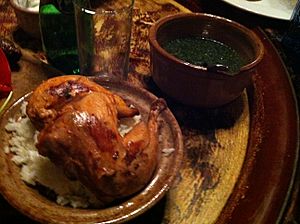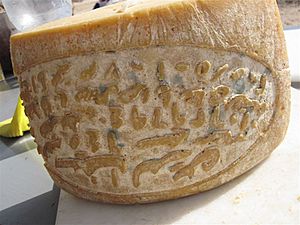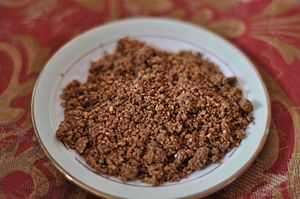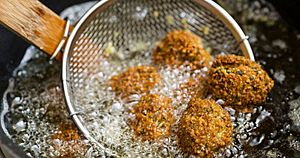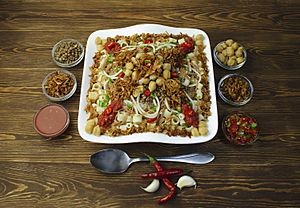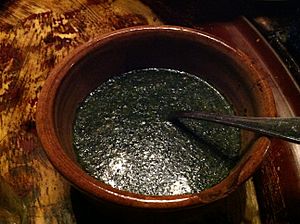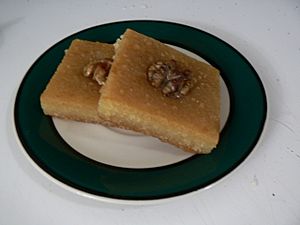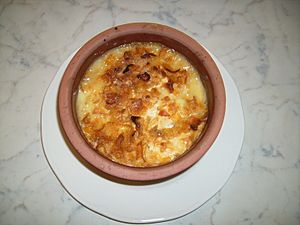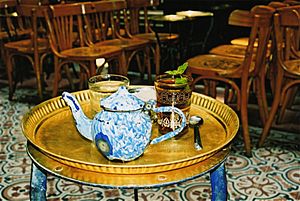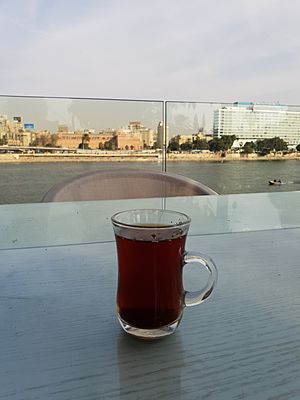Egyptian cuisine facts for kids
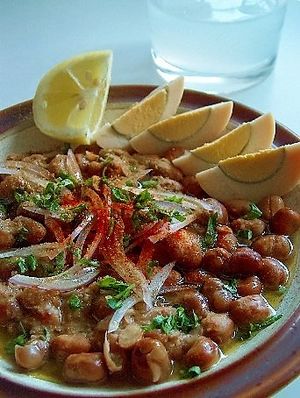
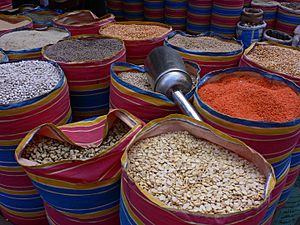
Egyptian cuisine uses a lot of poultry, beans (legumes), vegetables, and fruits. These come from Egypt's rich Nile Valley and Delta. Some famous Egyptian dishes include rice-stuffed vegetables and grape leaves, hummus, falafel, shawarma, kebab, and kofta. Other popular foods are ful medames (mashed fava beans), kushari (lentils and pasta), and molokhiya (a stew made from jute leaves).
A special kind of pita bread called eish baladi is a main food in Egypt. Egyptians have been making cheese since ancient times. Domiati is the most popular cheese eaten today.
Egyptian food uses many vegetables and legumes. But it also includes meats like pigeon, chicken, and lamb. Lamb and beef are often grilled. Some cities have popular fast foods made from organ meats. Foie gras, a special dish, has been made in Egypt since at least 2500 BCE. Fish and seafood are common in areas near the coast. A lot of Egyptian food is vegetarian. This is because meat used to be expensive. Also, Coptic Christians often eat plant-based meals for much of the year due to their religious rules.
Tea is Egypt's national drink. Beer is the most popular alcoholic drink. However, most Egyptians are Muslim, and many avoid alcohol.
Popular Egyptian desserts include baqlawa, basbousa, and kunafa. These sweets often use dates, honey, and almonds.
Contents
History of Egyptian Food
In medieval Egypt, people ate wheat, barley, and rice. There's some debate about whether millet was common. Some records say it was rare outside a small area. Others say it was very popular.
Sorghum was grown in Upper Egypt. But people in Cairo usually only ate it during famines. They preferred it over other emergency breads made from things like bran or broad beans.
An old Egyptian story, The Tale of Judar and His Brothers, mentions a special rice dish. It was called aruzz mufalfal. This dish was seasoned with cinnamon and saffron.
Ancient Egyptian cuisine included bread, beer, fruit, vegetables, and fish. Many old carvings show what people ate thousands of years ago.
What Makes Egyptian Food Special?
Egyptian food is great for vegetarians. It uses a lot of bean and vegetable dishes. While coastal areas use more fish, most Egyptian cooking focuses on foods grown from the ground.
Egypt's Red Sea ports were important for the spice trade. This easy access to spices has shaped Egyptian cooking over time. Cumin is the most used spice. Other common spices include coriander, cardamom, chili, aniseed, bay leaves, dill, parsley, ginger, cinnamon, mint, and cloves.
Common meats in Egyptian food are pigeon, chicken, and duck. These are often boiled to make broth for stews and soups. Lamb and beef are best for grilling. Grilled meats like kofta and kebab are called mashwiyat.
Organ meats are popular in Egypt. Liver sandwiches are a famous fast food in cities like Alexandria. These are chopped liver fried with bell peppers, chili, garlic, cumin, and other spices. They are served in a bread called eish fino. Cow and sheep brain are also eaten.
Foie gras is a special dish still enjoyed by Egyptians. It tastes rich and buttery. It can be served whole or as a mousse or pâté. This food has been made since 2500 BC. It involves feeding ducks and geese to make their livers larger.
Egyptian Cheeses
Cheese may have first been made in the Middle East. Two jars found in an ancient tomb in Saqqara had cheese from about 3000 BC. These were likely fresh cheeses. Another tomb from King Hor-Aha also had cheese.
Many people in rural areas still make their own cheese, like the fermented mish. But factory-made cheeses are becoming more common. Cheese is often eaten for breakfast. It's also in many traditional dishes and even some desserts.
Popular Egyptian cheeses include:
- Domiati: The most eaten cheese in Egypt.
- Areesh: Made from laban rayeb (fermented milk).
- Rumi: A hard, salty, aged cheese. It's similar to Pecorino Romano.
Bread: A Staple Food
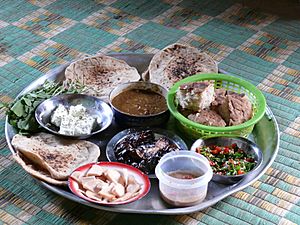
Simple bread is a core part of Egyptian food. It's eaten with almost every meal. For many working-class or rural Egyptians, a meal might just be bread and beans.
The local bread is a thick, hearty pita bread called eish baladi. The word eish means "to live" or "livelihood" in Arabic. This shows how important bread is to Egyptian life.
The Egyptian government helps keep bread prices low. This policy started a long time ago. In 2008, a food crisis caused long lines at bakeries. Sometimes fights even broke out over bread.
In cooking, bread is often used like a utensil. It provides energy (carbohydrates) and protein. Egyptians use bread to scoop up food, sauces, and dips. They also wrap kebabs and falafel in it. Most pita breads are baked at very high temperatures. This makes them puff up and create a pocket inside.
Common Egyptian breads include:
Starters and Salads
In Egypt, meze (small dishes) are called muqabilat. Salads and cheeses are usually served with bread at the start of a meal.
Popular starters include:
- Ta‘meya: Deep-fried fritters made from fava beans. (Unlike other falafel, which use chickpeas). Often eaten alone or in a pita sandwich.
- Baba ghannoug: A dip made from eggplant, lemon juice, and spices.
- Duqqa: A dry mix of chopped nuts, seeds, and spices.
- Gollash: A pastry (like phyllo dough) filled with minced meat or cheese.
- Salata baladi: A salad with tomatoes, cucumber, onion, and chili. It's topped with parsley, cumin, and vinegar.
- Tehina: A sesame paste dip with lemon juice and garlic.
- Torshi: A mix of pickled vegetables.
Main Courses: Hearty and Flavorful
Egyptian main dishes are known for ful medames (mashed fava beans) and kushari. Kushari is a mix of lentils, rice, and pasta. Molokhiya is a green soup made from chopped jute leaves with garlic. Feteer meshaltet is also a popular dish.
Egyptian food is similar to dishes from the Eastern Mediterranean. This includes rice-stuffed vegetables, grape leaves, shawerma, kebab, and kofta. But Egyptians have their own ways of preparing them.
Many consider kushari to be the national dish of Egypt. Ful medames is also very popular. Fava beans are also used to make ta‘ameya (falafel).
Ancient Egyptians used a lot of garlic and onions. Fresh garlic is used in spicy tomato salad and stuffed eggplant. Garlic fried with coriander is added to molokhiya. Fried onions are often added to kushari.
Here are some other main dishes:
| English Name | Arabic Name | What it is |
|---|---|---|
| Bamia | بامية | A stew with lamb, okra, and tomatoes. |
| Besarah | بصارة | A dip made from fava beans and leafy greens. Served cold with fried onion. |
| ‘Eggah | عجة | An omelette with parsley and flour, baked in the oven. |
| Fattah | فتة | A festive dish with rice, lamb, and bread pieces. Covered in tomato or vinegar sauce. |
| Fesikh | فسيخ | Salted or fermented mullet. Eaten during the spring festival of Sham Ennessim. |
| Feteer | فطير | Pies made of thin dough with butter (ghee). Can be savory or sweet. |
| Ful medames | فول مدمس | Cooked fava beans with olive oil and cumin. Eaten with bread. Often considered the national dish. |
| Hamam mahshi | حمام محشي | Pigeon stuffed with rice or green wheat and herbs. Boiled then roasted. |
| Hawawshi | حواوشى | A pastry filled with minced meat, onions, and peppers. |
| Kabab | كباب | Chopped lamb meat on skewers, grilled over charcoal. |
| Kamounia | كمونية | A beef and cumin stew. |
| Kaware‘ | كوارع | Cow's trotters. Often eaten with fattah or as a soup. |
| Kersha | كرشة | Tripe cooked into a stew. |
| Keshk | کشک | A savory yogurt pudding with flour. Sometimes has fried onions or chicken broth. |
| Kofta | كفتة | Minced meat with spices and parsley, shaped into fingers and grilled. |
| Kushari | كشري | A mix of rice, macaroni, and lentils. Topped with spiced tomato sauce, garlic vinegar, chickpeas, and fried onions. A popular street food. |
| Macarona bil-béchamel | مكرونة بالبشاميل | An Egyptian version of lasagna. Made with penne pasta, béchamel sauce, and ground beef. |
| Mahshi | محشي | Vegetables (like peppers, eggplants, zucchini, tomatoes) or leaves (grape, cabbage) stuffed with rice, tomatoes, onions, and herbs. Cooked in broth. |
| Mesaqa‘ah | مسقعة | Sliced eggplants baked with onions, peppers, and a red tomato sauce. |
| Molokhiya | ملوخية | Green soup made from finely chopped mallow leaves. Cooked with garlic, coriander, and chicken or other broth. Often considered the national dish. |
| Mombar | ممبار | Sheep intestines stuffed with rice and deep-fried. |
| Rozz me‘ammar | رز معمر | A rice dish baked with milk, butter or cream, and chicken broth. Served in a clay pot. |
| Sabanekh | سبانخ | A spinach stew, usually with rice. Often includes small pieces of beef. |
| Sayadiya | صيادية | A coastal dish. Rice cooked with onion and tomato paste, served with fried fish. |
| Shakshouka | شكشوكة | Eggs cooked in tomato sauce with vegetables. |
| Shawerma | شاورما | A popular sandwich with shredded beef, lamb, or chicken. Rolled in pita bread with tahini sauce. |
| Torly | تورلي | A baked dish with squash, potatoes, carrots, onions, and tomato sauce. |
| Qolqas | قلقاس | Taro root, prepared with chard or tomato. |
Delicious Egyptian Desserts
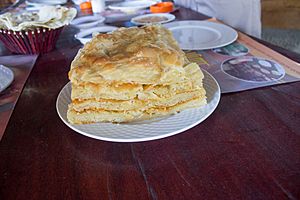
Egyptian desserts are similar to other sweets from the Eastern Mediterranean.
- Basbousa is a dessert made from semolina soaked in syrup. It's often topped with almonds and cut into diamond shapes.
- Baqlawa is a sweet dish with many layers of thin pastry (like phyllo pastry), nuts, and sweet syrup.
- Ghorayiba is a sweet biscuit made with sugar, flour, and lots of butter. It's like shortbread.
- Kahk is a sweet biscuit eaten during Eid al-Fitr. It's covered with icing sugar and can be filled with dates, walnuts, or a Turkish delight-like filling.
- Kunafa is a shredded pastry with a layer of cream or cheese, soaked in sweet syrup.
- Luqmet el qadi are small, round donuts. They are crunchy outside and soft and syrupy inside. Their name means "The Judge's Bite."
- Atayef is a dessert only served during Ramadan. It's a sweet mini pancake filled with cream and nuts or raisins.
- Rozz be laban is a rice pudding made with rice, milk, sugar, and vanilla. It can be topped with cinnamon, nuts, and ice cream.
- Umm Ali or Om Ali is a warm bread pudding made with puff pastry or rice, milk, coconut, and raisins.
Other desserts include:
- Couscous: Egyptian style, with butter, sugar, nuts, and dried fruit.
- Halawa
- Ladida
- Malban
- Mehalabeya
- Melabbes
- Mifattah: A thick paste of sesame and molasses.
Food and Religious Traditions
Even though Ramadan is a month of fasting for Muslims, it's a time when Egyptians focus on many different foods. Breaking the fast (called iftar) is a family event. Many special desserts, like kunafa and qatayef, are eaten only during Ramadan. During this month, many Egyptians set up special tables for the poor or travelers. These are called Ma'edet Rahman, meaning "Table of the Merciful."
Observant Christians in Egypt also have fasting periods. These can last for more than two-thirds of the year for some. During these fasts, Copts usually eat vegetables and beans cooked in oil. They avoid meat, chicken, and dairy products.
Popular Egyptian Drinks
Tea: The National Drink
Tea is the national drink in Egypt. Coffee is also popular, but not as much as tea. Egyptian tea is usually black and strong. It's often served in a glass, sometimes with milk. Most tea in Egypt comes from Kenya and Sri Lanka.
There are two main types of Egyptian tea:
- Kushari tea: Popular in Lower Egypt. Made by steeping black tea in boiled water. It's usually sweetened with sugar and often has fresh mint leaves. It's light in color and flavor.
- Sa‘idi tea: Common in Upper Egypt. Made by boiling black tea for up to five minutes. It's very strong and dark. It needs a lot of sugar because it can be bitter.
Tea is a big part of daily life and manners in Egypt. It's usually served with breakfast. Drinking tea after lunch is also common. When you visit someone's home, you'll almost always be offered a cup of tea. Serving tea to a visitor is seen as a "duty" (wa-jeb).

Besides regular tea, herbal teas are also popular. Karkadeh, made from dried hibiscus flowers, is very popular. It's usually served very sweet and cold, but can also be hot. This drink was supposedly a favorite of ancient pharaohs. In Egypt and Sudan, people often toast with hibiscus tea at weddings. Karkadeh is also believed to help lower blood pressure.
Other common herbal teas include mint, cinnamon, dried ginger, and anise. Sahlab is also popular. Many of these herbal teas are thought to have health benefits. For example, hot lemonade with mint and honey is used for mild sore throats.
Coffee: A Traditional Welcome
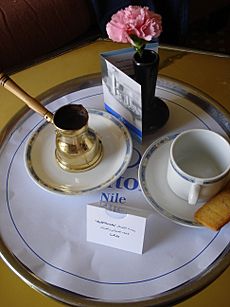
Coffee is a traditional welcome in Egypt. It's usually made like Turkish coffee in a small pot called a dalla or kanakah. It's served in a small cup called a fengan. The coffee is usually strong and can be sweetened in different ways:
- al riha: Lightly sweetened.
- mazbout: Medium sweetened.
- ziyada: Very sweet.
Unsweetened coffee is called sada.
Refreshing Juices
In Egypt, sugar cane juice is called aseer asab. It's a very popular drink sold by many fruit juice vendors in most cities.
Licorice teas and carob juice are traditionally enjoyed during the Islamic month of Ramadan. Amar al-din is also popular then. It's a thick drink made from dried apricot sheets mixed with water. The dried apricot sheets can also be eaten as candy. Sobia is another drink served during Ramadan. It's a sweet coconut milk drink.
A sour, chilled drink made from tamarind is popular in summer. It's called tamr hindi, which means "Indian dates" in Arabic.
See also
 In Spanish: Gastronomía de Egipto para niños
In Spanish: Gastronomía de Egipto para niños


